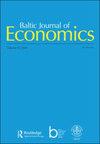The public–private sector wage gap in Latvia
IF 0.8
3区 经济学
Q3 ECONOMICS
引用次数: 8
Abstract
ABSTRACT This study investigates the public–private sector wage gap in Latvia using microdata from the labour force survey. The severity of public sector wage cuts employed as a response to the economic crisis and subsequent recovery provides a test bed to analyse whether and how the public–private sector wage gap has adjusted after consolidation-driven wage cuts. Findings reveal that the observed wage gap is slightly in favour of the public sector; however, once differences in individual characteristics and selection effects are considered, results point to a private sector wage premium. Findings also suggest that the private sector wage premium has increased since the pre-crisis period. A significant private sector wage premium raises doubts on whether a system that is reliant on discretionary fiscal measures is efficient enough in eliminating unwarranted differences in wage. In particular, whether a re-adjustment process of public sector wages works after consolidation-driven wage cuts.拉脱维亚公私部门的工资差距
摘要:本研究利用劳动力调查的微观数据调查了拉脱维亚公私部门的工资差距。公共部门为应对经济危机和随后的复苏而采取的减薪力度,提供了一个测试平台,可以分析在合并驱动的减薪之后,公私部门的工资差距是否以及如何调整。调查结果显示,观察到的工资差距略微有利于公共部门;然而,一旦考虑到个人特征和选择效应的差异,结果表明私营部门的工资溢价。调查结果还表明,自危机前以来,私营部门的工资溢价有所上升。私营部门显著的工资溢价令人怀疑,一个依赖于自由裁量的财政措施的体系,在消除不必要的工资差异方面是否足够有效。特别是,在合并驱动的工资削减之后,公共部门工资的重新调整过程是否有效。
本文章由计算机程序翻译,如有差异,请以英文原文为准。
求助全文
约1分钟内获得全文
求助全文

 求助内容:
求助内容: 应助结果提醒方式:
应助结果提醒方式:


